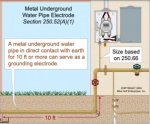jxofaltrds
Inspector Mike®
- Location
- Mike P. Columbus Ohio
- Occupation
- ESI, PI, RBO
With the limited information provided what would be your first assumption?
This is a real life problem. So let us see your troubleshooting abilities!

1. Improper bonding in ?sub? panel.
2. Gremlins
3. Dead short
4. Lost leg
5. Lost utility neutral
6. Everything is OK
7. Neighbor lost neutral
8. No big deal lights still work ? see it all the time
9. Current flowing through ground to utility
10. No ground rod present
This is a real life problem. So let us see your troubleshooting abilities!

1. Improper bonding in ?sub? panel.
2. Gremlins
3. Dead short
4. Lost leg
5. Lost utility neutral
6. Everything is OK
7. Neighbor lost neutral
8. No big deal lights still work ? see it all the time
9. Current flowing through ground to utility
10. No ground rod present



